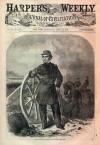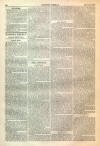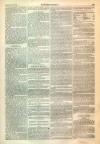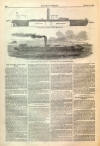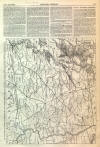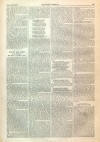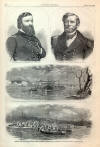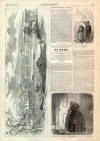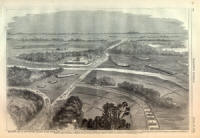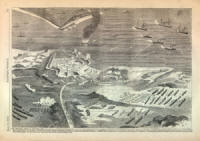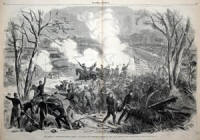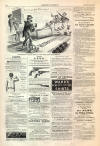Battle of Pittsburg Landing
|
|
This Site:
|
HARPER'S WEEKLY. [APRIL 26, 1862. 262 LONGITUDINAL SECTION OF THE "NAUGATUCK."THE STEVENS IRON STEAM GUN-BOAT "NAUGATUCK," NOW AT FORTRESS MONROE.THE ADVANCE UPON YORKTOWN.WE devote pages 260 and 261 to illustrations of our advance upon Yorktown. On page 260 we publish a view of GREAT BETHEL, WITH THE REBEL FORTIFICATIONS, from a sketch by an officer of the Topographical Engineers. A correspondent of the World thus alluded to the entry of our troops: Colonel Spear, with his cavalry, dashed down the road, carrying every thing before them. The two columns, having joined near Big Bethel, soon found themselves within sight of the works where the heroic Grebel fell fighting at his gun and Winthrop breathed his last cheering on his men. Finding nothing to oppose their march, they were soon inside the works of Great Bethel, and found that they were mere sand batteries, with embrasures for about sixty guns, mounting light field artillery. The enemy, at the approach of our troops, fled and carried off the guns which were there. The force behind these intrenchments was at least 1500 strong, including a company of cavalry. Our troops destroyed the works and proceeded onward to within eight miles of Yorktown. In an open field of about eight or nine hundred acres, above the Half-way House, some infantry were drawn up in line of battle. It was deemed inexpedient to bring on an engagement, and as all was accomplished that was undertaken, our troops took up their line of march toward camp. On the following page (261) we give a picture (from a sketch by the same hand) of the FIRST DAY'S FIRING AT YORKTOWN—5th April. The following account we take from the Herald correspondence: At seven o'clock A.M. the divisions left Cockletown. The order of march was the same as on the previous day, excepting that the Fourth Michigan regiment, Colonel Woodbury, led the infantry. Colonel Averill's cavalry and Berdan's Sharp-shooters kept the advance of the column. For about an hour in the march a heavy rain fell; but the troops apparently did not heed it; neither did they seem to mind the bad and muddy road, extending about three miles through a region of swamp. In some places the mud was up to the men's knees. The artillery had hard work to move on. At intervals the roads were blocked, impeding the progress of the troops. About four miles advance and the marsh was passed, and the column came into good roads, and in a cultivated and beautiful section of the country. It was inspiring to the troops. Passing by Cheeseman and Goose Creeks and Grafton Chapel, our column came in sight of the earth-works of the enemy, and York River to the right and beyond. General Heintzelman was present to direct arrangements. In the excitement soldiers forgot their weariness. It was believed a battle would soon be fought. Colonel Averill's cavalry and the Berdan Sharp-shooters kept ahead, on the vigilant look-out for rebels and masked batteries. General Porter's brigade steadily advanced toward the earth-works, although there were no supporting troops behind for some distance, and wholly ignoring the thought of the force the enemy might bring against them. The brigades were put in position. Captain Griffin's and Captain Weeden's batteries took places on the brow of a hill in face of the rebel intrenchments. On the right, in a piece of woods, lay General Morell's brigade, to support the batteries. Beyond the woods, in a peach orchard, were the Berdan Sharp-shooters; they were eight hundred yards from the intrenchments. Our artillery was fifteen hundred yards distant from the enemy. At ten o'clock the first shot was fired. It came from one of the rebel works to the right. The shot went over our field-pieces, and came near where Generals Porter and Morell and other officers were standing. It struck heavily in the sand, but did not explode. A quick response followed from Captain Weeden's battery, which brought an immediate rejoinder. This second shot, a solid one, struck one of the gunners, named Reynolds, on the right leg below the thigh. The limb was amputated; but he died fifteen minutes after the operation. A continuous firing was kept up an hour and a half; subsequently intervals of from fifteen to twenty minutes occurred between the shots. The enemy fired mainly heavy guns, from twelve to twenty-four pounders. Only four of the enemy's shells burst. Our boys did not seem to mind them much, but rather enjoyed the thing. One shot struck in the Ninth Massachusetts Regiment, ricocheted, and wounded two men of the Sixty-second Pennsylvania Regiment. General Morell and staff and General Martindale and staff were in the foremost places of danger with their regiments. The Berdan Sharp-shooters made fearful havoc among the enemy's gunners, picking them off by the dozen. Colonel Berdan says they killed at least fifty of the rebels and wounded a hundred. Toward night the enemy commenced shelling them by running a gun out from behind the left end of the fort, discharging it and then dragging it in to load again, the only way they were enabled to work the gun. They tried the plan of covering the working of guns by running a plank upon the parapet, and turning it upon the edge; but they did not seem to like to trust it. The attempt at shelling was not long continued. As soon as a gunner showed himself the aim of the unerring rifle would enforce on him the propriety of retirement. At first the rebel sharp-shooters attempted to shoot our men from rifle-pit; but they found even these places too hazardous, and were not long in withdrawing to safer positions behind the intrenchments. During the afternoon a small mounted party, led by an officer wearing a white shirt, the bosom of which was distinctly visible, ventured outside the fort. A member of the sharp-shooters, who goes by the soubriquet of "California Joe," observed that "he was best at a white mark." He quickly drew up his telescopic rifle, took aim, fired, and the man reeled in his saddle and fell to the ground apparently dead. At half past four P.M. the enemy opened heavy firing from earth-works on the left of where the above shooting occurred. They made General Martindale's brigade their target. Our people were ready for them. The Third Massachusetts battery took a position, and returned the fire with splendid, and, as is believed, most telling effect. The rebel gunners showed more skill in sighting their pieces here than was shown from the other portion of the intrenchment. The sun was shining on our pieces, which gave the enemy a great advantage. Before the firing ceased General Hamilton's division arrived on the ground. Captain Randolf's Sixth Rhode Island battery relieved during the last of the firing the Third Massachusetts battery. The rebels had fine range of the best locations for our artillery and the grounds on which we were encamped; but the casualties were very slight indeed compared with the injuries which our sharp-shooters inflicted upon them. Whenever they made a good shot they would utter unearthly yells. The principal portion of our troops which had arrived were located in the large fields on either side of the road, nearly surrounded by woods. In front, where our pieces were planted, there is an extensive field and then a lower ground, a large plain, in front of the rebel works. The Yorktown turnpike runs through to the centre of the fortifications, which have dense woods behind them. THE VICTORY AT ISLAND No. 10.WE devote page 268 to illustrations of the SIEGE OF ISLAND NUMBER TEN, on the Mississippi, which was surrendered to Commodore Foote on the morning of 7th inst. We give a portrait of the gallant COMMODORE; a portrait of GENERAL POPE, whose brilliant "traverse movement" led to the capture of 4 generals and 5000 rebels; a view of the "CARONDELET" GUN-BOAT PASSING THE REBEL BATTERIES; and a picture of the GALLANT EXPLOIT OF COLONEL ROBERTS, who, with 100 men, surprised a rebel battery and spiked the guns. The following sketches of Commodore Foote and General Pope will be read with interest: COMMODORE FOOTE.Commodore Foote is a native of Connecticut, of which State he is a citizen, and from which State he was appointed to the navy of the United States. He is a son of Senator Foote, of Connecticut, to whom Daniel Webster replied, in the Senate, with one of his famous speeches. He entered the United States service on the 4th of December, 1822, and has consequently served the country nearly forty years. He steadily rose in his profession, and was made a commander on the 19th of December, 1852, under which commission he saw about two years and three months' sea-service. His total sea-service was nearly twenty years and a half, and he performed nearly eight years' shore duty. He was unemployed for over ten years, and was last at sea in June, 1859. At the breaking out of the present troubles he was in command of the Navy-yard at Brooklyn, and shortly after the commencement of hostilities was promoted to a captaincy, with the charge of the Western or Mississippi flotilla, of which he is the commodore or flag-officer. While engaged in his ditties he is reported as having worked night and day with a zeal and energy that are worthy of emulation in both branches of the service, and has accomplished an almost herculean task. Being dependent upon the Navy Department for men and a portion of his equipment, and compelled to call upon the War Department for other things equally necessary to the success of his mission in the inland waters, and apparently an object of jealousy and a subject of neglect from both, he has quietly worked through all obstacles. He is a quiet, gray-haired veteran, and, although holding a rank equal to major-general of the land forces, attained by a life's service on the broad seas under the old flag, has been quietly and unostentatiously serving his country at the junction of the Ohio and the Mississippi. His present expedition has been carried out with spirit and energy, and the result is gratifying to the nation. GENERAL POPE.General John Pope was born in Kentucky, about the year 1822. He entered the Military Academy at West Point in 1838, and graduated in 1842 as Second-Lieutenant of Topographical Engineers. He was in the Mexican war, and at Monterey so distinguished himself that he obtained his First-Lieutenancy. Again at Buena Vista he won laurels and the brevet rank of Captain. He was still a Captain when the rebellion broke out, and was one of the officers appointed by the War Department to escort President Lincoln to Washington. He was loyal, and was soon after the inauguration appointed to a command in the Northwest. For some time he served gallantly in Northern Missouri, under Generals Fremont and Hunter. General Halleck gave him command of a separate expedition in December. He started from Commerce, Missouri, with a well-appointed command of some 12,000 men, and marched over to New Madrid, then occupied by the rebels. He took the place, erected batteries all along the west bank of the river for fifteen miles, and captured the rebels from Island No. 10. THE EXPLOIT OF THE "CARONDELET."The New York Times correspondent thus describes the exploit of the Carondelet. After describing the efforts made to send transports through the bayous to General Pope at New Madrid, and the necessity of having a gun-boat to protect them crossing over the troops, he says: Why the Carondelet was selected particularly for this enterprise I do not know. Some boat had to go, and Captain Walke, being nearly the oldest officer in the fleet, and having on all occasions performed excellent service, was dispatched for the enterprise. The preparations made were few. On the port side a flat-boat was lashed, loaded with bales of pressed hay, and calculated to afford considerable protection against batteries located on the Kentucky shore. If they got through safely she would need fuel, and to supply this a barge laden with coal was lashed to the opposite side, and by balancing the breast-work of hay, enabled her to be more easily handled. During the day (Friday) two of her how guns were removed, and their places supplied with rifled Dahlgren pieces of 30 and 42 pounds calibre respectively. This was all the preparation made, and, thus accoutred, she waited for night, whose black mantle would, to some extent, lessen the danger of the attempt. At 10 o'clock she cast loose, and started slowly down the stream. At the same time heavy clouds had overspread the sky, and a genuine tropical (in size) thunder-storm came howling up the river. It did not rain in the ordinary meaning of the term, but whole gulfs of water came pouring down in masses. Nor did it thunder and lighten in the usual meaning given to those words, but it roared at us as if all the electric batteries of north, south, east, and west, had concentrated their forces, and were bellowing at us in unison, while the lightning in each broad flash was so vast and so vivid, that it seemed as if the gates of some hell, like that of Milton, were opened and shut every instant, suffering the whole fierce reflection of the infernal lake to flash across the sky. At such a time the Carondelet lifted her anchor, and slowly swung into the stream, watched, through the almost blinding flashes, by thousands of eager eyes, whose owners, regardless of the driving storm, crowded the decks of the other gun-boats and transports, to watch the heroic undertaking. Slowly she swung round till hauled down stream, and then she pushed straight ahead, keeping well over toward the island. We could see her almost every second—every brace, port, and outline could be seen with startling distinctness enshrouded by a bluish-white glare of light, and then her black form for the next instant would become merged in the intense blackness that lay upon the river like a pall. With beating hearts we saw her arrive opposite to, and pass the first battery on the Kentucky shore, without a demonstration from the enemy. But just below was another battery, whose guns had often pitched their immense balls a clear distance of four miles; and with hearts whose beating could almost, it seemed, be heard beneath our jackets, we watched her slowly approaching, in checkers of darkness and flame, the dreaded works. A crashing peal of thunder—a blinding flash of light, which scarcely had disappeared when a broad blaze of flame burst from the fortifications, followed almost instantly by a second and a third. A few instants later, and the reports came up to us dulled by the roar of the storm. No reply from the Carondelet. Slowly she steamed ahead, the sky all ablaze about her, the Kentucky shore vomiting fierce flames, the thunders of the storm and the roar of the rebel artillery commingling, as if heaven and earth had joined to crush the audacious intruder. In about twenty minutes the Carondelet had passed below the island, chased all the way by the outbursting flashes along the shore, roared at by the thunders above, beset by the rain, and buffeted by the savage winds. Then the flashes along the shore ceased, and then came a few moments of terrible suspense. Had she gone down, or was she drifting helpless in the swift current? Just then the roar of a gun came up faintly from below, then another, and another. It was the signal that she had passed through safely; and then there went up such thunders of cheers and hurricanes of shouts from the watching crowds, that even the storm itself was outroared, and the voice of our jubilation sent down to the rebels, who were gnashing their teeth in baffled rage behind their fortifications. To conclude, I will add that forty-seven shots were fired at the Carondelet, not one of which struck her! She lay off last night a short distance above New Madrid, and this morning early steamed up to the landing. Such another scene of rejoicing at her arrival was probably never witnessed. Men hurrahed, cried, laughed—they fired cannon, tossed up their hats; and finally their excitement culminated in seizing the crew of the boat that came ashore from the Carondelet, and carrying them on their shoulders in triumph all over the town. [For an account of Colonel Roberts's exploit, see page 259.]
THE BATTLE OF PITTSBURG
|
||||||||||||||||||||||
|
|
||
|
|
Site Copyright 2003-2018 Son of the South. For Questions or comments about this collection, contact paul@sonofthesouth.net |
|
|
Are you Scared and Confused? Read My Snake Story, a story of hope and encouragement, to help you face your fears. |
||
